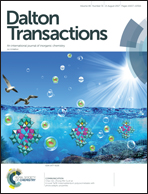Structure and reactivity of [RuII(terpy)(N^N)Cl]Cl complexes: consequences for biological applications†
Abstract
The crystal structures of [RuII(terpy)(bipy)Cl]Cl·2H2O and [RuII(terpy)(en)Cl]Cl·3H2O, where terpy = 2,2′:6′,2′′-terpyridine, bipy = 2,2′-bipyridine and en = ethylenediamine, were determined and compared to the structure of the complexes in solution obtained by multi-nuclear NMR spectroscopy in DMSOd-6 as a solvent. In aqueous solution, both chlorido complexes aquate fully to the corresponding aqua complexes, viz. [RuII(terpy)(bipy)(H2O)]2+ and [RuII(terpy)(en)(H2O)]2+, within ca. 2 h and ca. 2 min at 37 °C, respectively. The spontaneous aquation reactions can only be suppressed by chloride concentrations as high as 2 to 4 M, i.e. concentrations much higher than that found in human blood. The corresponding aqua complexes are characterized by pKa values of ca. 10 and 11, respectively, which suggest a more labile coordinated water molecule in the case of the [RuII(terpy)(en)(H2O)]2+ complex. Substitution reactions of the aqua complexes with chloride, cyanide and thiourea show that the [RuII(terpy)(en)(H2O)]2+ complex is 30–60 times more labile than the [RuII(terpy)(bipy)(H2O)]2+ complex at 25 °C. Water exchange reactions for both complexes were studied by 17O-NMR and DFT calculations (B3LYP(CPCM)/def2tzvp//B3LYP/def2svp and ωB97XD(CPCM)/def2tzvp//B3LYP/def2svp). Thermal and pressure activation parameters for the water exchange and ligand substitution reactions support the operation of an associative interchange (Ia) process. The difference in reactivity between these complexes can be accounted for in terms of π-back bonding effects of the terpy and bipy ligands and steric hindrance on the bipy complex. Consequences for eventual biological application of the chlorido complexes are discussed.
![Graphical abstract: Structure and reactivity of [RuII(terpy)(N^N)Cl]Cl complexes: consequences for biological applications](/en/Image/Get?imageInfo.ImageType=GA&imageInfo.ImageIdentifier.ManuscriptID=C7DT01669G&imageInfo.ImageIdentifier.Year=2017)


 Please wait while we load your content...
Please wait while we load your content...